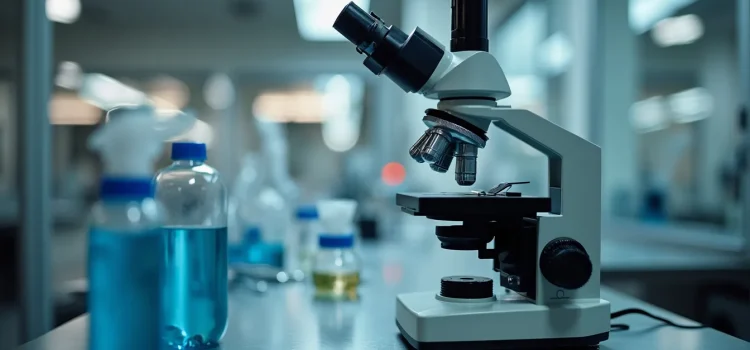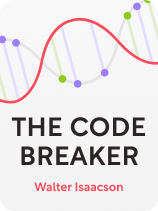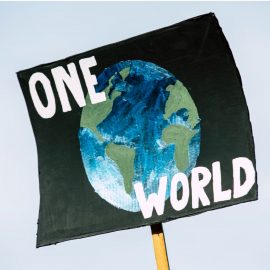

This article is an excerpt from the Shortform book guide to "The Code Breaker" by Walter Isaacson. Shortform has the world's best summaries and analyses of books you should be reading.
Like this article? Sign up for a free trial here.
Who invented CRISPR technology? Was it a solo effort or a collaborative achievement?
The development of CRISPR gene editing technology involved multiple scientists, each contributing crucial elements. Jennifer Doudna, Emmanuelle Charpentier, and Feng Zhang played significant roles in transforming CRISPR from a natural process into a powerful gene editing tool.
Read on for the fascinating story of scientific discovery, collaboration, and competition that led to one of the most revolutionary breakthroughs in modern biology.
The Invention of CRISPR Technology
In his book The Code Breaker, Walter Isaacson explains that, after Jennifer Doudna helped discover how CRISPR-Cas9 works in nature, she focused on developing the system into a technology for human use. So, who invented CRISPR technology? Was it Doudna? Isaacson writes that Doudna played a huge role in the development of CRISPR technology, but she didn’t do it alone—both colleagues and competitors helped her establish this scientific innovation. Let’s discuss the contributions each key player made toward the advent of CRISPR technology.
Doudna Collaborates With Charpentier
Around the same time that Doudna began researching Cas enzymes, other scientists were conducting experiments aimed at preventing viral infections in the bacteria used to make yogurt. They discovered that they could insert CRISPR elements into bacterial cells instead of waiting for cells to naturally develop CRISPR-derived immune defenses. The scientists also confirmed that cells’ CRISPR defenses were inheritable. Based on this discovery, the scientific community concluded that it could potentially use CRISPR to create inheritable alterations to any type of gene.
(Shortform note: Ever since scientists discovered that they could use CRISPR to enhance yogurt production, dairy producers have been using it to protect their products—which means you’ve probably eaten CRISPR-optimized yogurt or cheese. When scientists discovered that the bacteria in their experiment could inherit CRISPR-derived immunity to viruses, some argued that this was a rare case of Lamarckian inheritance: offsprings’ inheritance of characteristics the parent acquired over its lifetime (as opposed to the characteristics the parent was born with). Darwin helped popularize the theory of Lamarckian inheritance, but most evidence has suggested the theory is false—so whether CRISPR is Lamarckian is controversial.)
Doudna and Charpentier turned this potentiality into an actuality, writes Isaacson. They realized that, since crRNA determined which genes to cut out of a virus, they could use different versions of crRNA with different targets to edit any segment of DNA they wanted. To simplify this process, they fused together crRNA and tracrRNA to create sgRNA (single-guide RNA) in 2013. The invention of sgRNA transformed CRISPR from a biological process into a gene editing tool. They experimented with single-celled organisms and proved that they could edit genes at will. Isaacson explains that other gene editing tools already existed, but CRISPR gene editing technology quickly displaced them because it was more straightforward and efficient.
(Shortform note: The sgRNA tool that Doudna and Charpentier invented remains the most popular gRNA (guide RNA) tool for CRISPR gene editing, but there are thousands of alternatives, including dual-guide RNA that doesn’t combine crRNA and tracrRNA. Each type has its own benefits and drawbacks—for example, sgRNA tends to be more expensive than two-part gRNA, but two-part gRNA can be harder to use efficiently. The development of various gRNA tools is part of what helped CRISPR displace other gene editing technologies—the gRNA molecules are easily customizable to different purposes, whereas older technologies are not.)
Doudna Competes With Zhang (and Other Scientists)
Isaacson explains that, although Doudna and Charpentier successfully demonstrated that they could edit the genes of single-celled organisms, it wasn’t immediately clear that the same process could be used in more complex cells (like human cells). As soon as Doudna and Charpentier published their paper on CRISPR gene editing technology, scientists around the world began competing to become the first to use it in human cells. Doudna’s primary competitor in this race was Feng Zhang, a Harvard-educated biochemist with expertise in earlier forms of gene editing technology.
Zhang says that he independently figured out how CRISPR works and used it to edit human and mouse cells by the middle of 2012. But Isaacson explains there are two reasons not to give Zhang credit for the invention of CRISPR gene editing technology: First, according to Zhang’s own records, he didn’t understand how important Cas9 and tracrRNA were to the CRISPR process; Doudna and Charpentier definitely made that discovery. Second, Zhang didn’t create sgRNA (the synthetic molecule that transformed CRISPR from a natural process into a technology)—Doudna and Charpentier did. However, Zhang disagrees that sgRNA is integral to the technology, and Doudna’s lab discovered that sgRNA doesn’t work well for editing human cells.
According to Isaacson, the race to optimize CRISPR gene editing technology for human cells was close. Zhang made modifications to the original version of sgRNA that Doudna and Charpentier developed. His paper was published the same day as another scientist’s paper, and the other scientist’s modifications to sgRNA proved more suitable for human DNA editing than Zhang’s. Later the same month, Doudna published her own paper, which demonstrated another way to apply CRISPR to human cells. Two other scientists published papers on the same topic that year. Since multiple scientists made significant contributions to the application of CRISPR gene editing technology in human cells, it was difficult to say who invented the process.
| Comparing Doudna’s and Zhang’s Contributions to CRISPR Science Isaacson explains that, when Doudna and Charpentier first invented the CRISPR tool, it wasn’t clear whether it would work in complex cells like human cells. But in the war for patent rights (which we’ll cover soon), Doudna’s lawyers argued just the opposite: The average expert could have reasonably expected to succeed in using CRISPR technology in eukaryotic (complex) cells since several scientists achieved that feat quickly after CRISPR’s development. However, since Doudna and Charpentier explicitly stated that they didn’t expect to accomplish this easily, it’s significant that Zhang was the first to actually do so, even though he didn’t completely understand the roles of Cas9 and tracrRNA in the process. However, neither Zhang nor Doudna—nor any other scientist—safely optimized CRISPR for use in human cells (although scientists continue to research solutions to this problem). Many different gRNA tools have been invented to suit various gene editing projects’ particular needs (including sgRNA optimized for use in human cells), and some experts suggest that dual-guide and single-guide RNA work equally well. This fact may support Zhang’s argument that Doudna and Charpentier’s sgRNA isn’t integral to CRISPR gene editing technology, undermining the pair’s case for patent rights. |
The War for Patent Rights and Recognition
Isaacson explains that both academia and the biotechnology industry are extremely competitive. In academia, being the first to make a discovery leads to greater prestige and career success. In the biotechnology industry, being first enables you to develop patents. (Shortform note: Patents are important to inventors because they prevent others from taking credit for or profiting from your invention, which enables you to make more money.)
The competitive nature of scientific research—and the ambiguity surrounding who truly invented the process for human gene editing—led Doudna, Charpentier, and Zhang to become embroiled in a war for patent rights and recognition. Let’s explore how that played out.
In 2013, Doudna, Zhang, and other scientists established a CRISPR-focused medical research company together called Editas Medicine. However, Doudna left the company a few months later due to a conflict: Doudna and Charpentier had applied for a patent together, as had Zhang and his team. Zhang paid to accelerate the application process, so he was granted the patent for CRISPR first. Isaacson says that Doudna felt this was unfair: She believed she and Charpentier were the first to develop the technology, and she thought Zhang’s actions were underhanded and proved him untrustworthy. She left Editas Medicine to join Intellia, an offshoot of a biotechnology company she’d built earlier in her career (Caribou Biosciences).
Meanwhile, conflict was also brewing between Doudna and Charpentier: Charpentier viewed herself as the primary researcher who discovered CRISPR technology, while Doudna felt it was a joint project for which she was entitled equal recognition. Due to this conflict, Charpentier formed her own biotechnology company instead of joining Doudna (or Zhang). (Shortform note: It’s unclear whether Doudna and Charpentier have bridged the gap that grew between them. But as of 2023, they continue to have collegiate links—Doudna’s Innovative Genomic Institute celebrated the many strides made by Charpentier’s company, CRISPR Therapeutics, toward further applications of CRISPR technology.)
Nevertheless, Doudna and Charpentier were jointly awarded several prizes for their work on CRISPR. Isaacson explains that these prizes affirmed two things: Doudna and Charpentier had made relatively equal contributions, and despite Zhang’s patent approval, they were the first to discover the technology. These affirmations were echoed by the greater scientific community when one of Zhang’s associates published an article lauding Zhang for his contributions to the discovery. Critics of the article argued that the article’s writer ignored Doudna’s contributions because he was sexist, which led to a Twitter firestorm.
(Shortform note: Twitter has long served as a digital hub for professionals in academia (but this has changed somewhat since Elon Musk took ownership of the platform). So-called Academic Twitter is good for building rapport among colleagues regardless of physical distance, but it’s also been home to several career-stopping academic scandals over the years. In addition to the Twitter firestorm over who deserved credit for CRISPR’s development, Doudna and Zhang’s respective companies waged a silent online battle over their claims to CRISPR-related Twitter handles).
Isaacson explains that, since their application was still being processed when Zhang’s patent was awarded, Doudna and Charpentier were legally entitled to continue fighting for patent rights. They argued in court that they deserved the patent because they were the first to develop CRISPR gene editing technology and to say that it could be used in human cells. Zhang countered that he deserved the patent because Doudna and Charpentier’s original version of sgRNA didn’t work in humans and his innovation solved that problem. The US Patent Office determined Zhang should have the patent after all, but Doudna and Charpentier won other patent wars abroad, in nations like Mexico, China, New Zealand, and Japan.
| The Fallout of the Patent Wars The patent wars between Zhang and Doudna and Charpentier haven’t been resolved—and at times, they’ve gotten grisly. Doudna’s lawyers accused Zhang of knowingly misrepresenting the truth in his patent applications, citing email admissions from a researcher in his lab as evidence. Zhang and his representatives denied these charges; since he was ultimately awarded a patent, it’s probable that the courts didn’t find substantial enough evidence that he lied. However, the patent war didn’t end there—Doudna continued to file for CRISPR-related patents, which prompted patent authorities to re-investigate the issue. In a 2022 decision, the patent court again upheld Zhang’s original patent grant. Doudna’s US appeal of Zhang’s patent victory was pending as of July 2023. Other authorities, including Japan’s Patent Office and the National Inventors Hall of Fame, recognize Doudna and Charpentier as the first to invent CRISPR for eukaryotic gene editing. Some experts believe that Zhang’s victory in the patent wars for CRISPR technology could jam up the deployment of CRISPR therapies with patent infringement lawsuits. However, suing people who use the technology could harm Zhang’s reputation, since Americans are increasingly critical of greedy behavior in the medical technology and pharmaceutical industry. Zhang’s employer, the Broad Institute, committed to sharing access to CRISPR technology with global scientists for therapeutic and agricultural research. And in 2023, Zhang’s company Editas Medicine licensed CRISPR to Vertex Pharmaceuticals for sickle cell disease therapy. |

———End of Preview———
Like what you just read? Read the rest of the world's best book summary and analysis of Walter Isaacson's "The Code Breaker" at Shortform.
Here's what you'll find in our full The Code Breaker summary:
- The fascinating story of the groundbreaking CRISPR gene editing technology
- Why CRISPR presents scientists and citizens with serious moral quandaries
- How CRISPR has already changed life as we know it—and how it has the potential for even more






